Deck 13: Quasi-Experiments and Small-N Designs
Question
Question
Question
Question
Question
Question
Question
Question
Question
Question
Question
Question
Question
Question
Question
Question
Question
Question
Question
Question
Question
Question
Question
Question
Question
Question
Question
Question
Question
Question
Question
Question
Question
Question
Question
Question
Question
Question
Question
Question
Question
Question
Question
Question
Question
Question
Question
Question
Question
Question
Question
Question
Question
Question
Question

Unlock Deck
Sign up to unlock the cards in this deck!
Unlock Deck
Unlock Deck
1/55
Play
Full screen (f)
Deck 13: Quasi-Experiments and Small-N Designs
1
Dr.Fletcher is interested in whether joining a fraternity/sorority causes people to become more concerned about their attractiveness and appearance.He recruits a group of 55 freshmen
(25 males,30 females)who are planning to go through fraternity/sorority recruitment on his campus.After they join,he gives them a measure of attractiveness concern/appearance concern (the Body Concern Scale).
In addition to measuring the body concern of the participants who joined a fraternity/sorority both immediately before and immediately after they join,Dr.Fletcher measures them for the three weeks before and the three weeks after.This type of design would be able to better address which of the following threats to internal validity?
A)History
B)Testing
C)Selection-history
D)Experimenter bias
Testing
2
Dr.Fletcher is interested in whether joining a fraternity/sorority causes people to become more concerned about their attractiveness and appearance.He recruits a group of 55 freshmen
(25 males,30 females)who are planning to go through fraternity/sorority recruitment on his campus.After they join,he gives them a measure of attractiveness concern/appearance concern (the Body Concern Scale).
In addition to measuring the body concern of the participants who joined a fraternity/sorority both immediately before and immediately after they join,Dr.Fletcher measures them for the three weeks before and the three weeks after.This type of design is known as a/an:
A)Nonequivalent control group design
B)Nonequivalent groups interrupted time-series design
C)Interrupted time-series design
D)Multiple-baseline design
Interrupted time-series design
3
Dr.Fletcher is interested in whether joining a fraternity/sorority causes people to become more concerned about their attractiveness and appearance.He recruits a group of 55 freshmen
(25 males,30 females)who are planning to go through fraternity/sorority recruitment on his campus.After they join,he gives them a measure of attractiveness concern/appearance concern (the Body Concern Scale).
In addition to measuring the group of participants who joined a fraternity/sorority,Dr.Fletcher decides to give the same measure to another group of 55 participants who decided to not join a fraternity/sorority.After conducting the study,Dr.Fletcher finds out that the people who joined a fraternity/sorority all saw a documentary on body image sponsored by the InterGreek Council the night before recruitment began.This threat to internal validity is known as a:
A)Selection threat
B)Selection-history threat
C)History threat
D)Testing threat
Selection-history threat
4
Which of the following designs has elements of both a within-group design and an independent-groups design?
A)Nonequivalent groups interrupted time-series design
B)Nonequivalent control group design
C)Matched group factorial design
D)Multiple regression design
A)Nonequivalent groups interrupted time-series design
B)Nonequivalent control group design
C)Matched group factorial design
D)Multiple regression design

Unlock Deck
Unlock for access to all 55 flashcards in this deck.
Unlock Deck
k this deck
5
Dr.Fletcher is interested in whether joining a fraternity/sorority causes people to become more concerned about their attractiveness and appearance.He recruits a group of 55 freshmen
(25 males,30 females)who are planning to go through fraternity/sorority recruitment on his campus.After they join,he gives them a measure of attractiveness concern/appearance concern (the Body Concern Scale).
Which of the following would Dr.Fletcher need to do to his current study design to make it an interrupted time-series design?
A)Recruit a group of participants who joined a fraternity/sorority at a different school
B)Take measurements of body concern before and after joining a fraternity/sorority
C)Measure body concern using a different measure than the Body Concern Scale
D)Add an additional variable,such as self-esteem

Unlock Deck
Unlock for access to all 55 flashcards in this deck.
Unlock Deck
k this deck
6
The degree to which a quasiexperiment supports a causal claim depends on which of the following:
A)Its design and its results
B)Its duration and its sample size
C)Its importance and its external validity
D)Its statistical significance and its practical significance
A)Its design and its results
B)Its duration and its sample size
C)Its importance and its external validity
D)Its statistical significance and its practical significance

Unlock Deck
Unlock for access to all 55 flashcards in this deck.
Unlock Deck
k this deck
7
Which of the following is true of the difference between large-N experiments and small-N experiments?
A)Small-N designs determine whether a finding is replicable by doing a test of statistical significance.
B)Data from small-N designs are presented as averages.
C)Data from small-N designs are grouped together.
D)Each person in a small-N design is treated as a separate experiment
A)Small-N designs determine whether a finding is replicable by doing a test of statistical significance.
B)Data from small-N designs are presented as averages.
C)Data from small-N designs are grouped together.
D)Each person in a small-N design is treated as a separate experiment

Unlock Deck
Unlock for access to all 55 flashcards in this deck.
Unlock Deck
k this deck
8
In conducting quasi-experimental designs,researchers tend to give up some ________ in exchange for ________.
A)Internal validity;external validity
B)Internal validity;statistical validity
C)Statistical validity;external validity
D)Construct validity;statistical validity
A)Internal validity;external validity
B)Internal validity;statistical validity
C)Statistical validity;external validity
D)Construct validity;statistical validity

Unlock Deck
Unlock for access to all 55 flashcards in this deck.
Unlock Deck
k this deck
9
Which of the following is an independent-groups quasi-experimental design?
A)Interrupted time-series design
B)Nonequivalent control group design
C)Nonequivalent groups interrupted time-series design
D)Stable-baseline design
A)Interrupted time-series design
B)Nonequivalent control group design
C)Nonequivalent groups interrupted time-series design
D)Stable-baseline design

Unlock Deck
Unlock for access to all 55 flashcards in this deck.
Unlock Deck
k this deck
10
Dr.Fletcher is interested in whether joining a fraternity/sorority causes people to become more concerned about their attractiveness and appearance.He recruits a group of 55 freshmen
(25 males,30 females)who are planning to go through fraternity/sorority recruitment on his campus.After they join,he gives them a measure of attractiveness concern/appearance concern (the Body Concern Scale).
If Dr.Fletcher is interested in a causal relationship between joining a fraternity/sorority and attractiveness/appearance concern,why doesn't he conduct a true experiment?
A)It is not possible to study private organizations,like fraternities/sororities.
B)It is not possible to measure body concern.
C)He was unable to recruit an equal number of males and females.
D)He was unable to randomly assign participants to join a fraternity/sorority.

Unlock Deck
Unlock for access to all 55 flashcards in this deck.
Unlock Deck
k this deck
11
Dr.Fletcher is interested in whether joining a fraternity/sorority causes people to become more concerned about their attractiveness and appearance.He recruits a group of 55 freshmen
(25 males,30 females)who are planning to go through fraternity/sorority recruitment on his campus.After they join,he gives them a measure of attractiveness concern/appearance concern (the Body Concern Scale).
In addition to measuring the group of participants who joined a fraternity/sorority,Dr.Fletcher decides to give the same measure to another group of 55 participants who decided to not join a fraternity/sorority.Doing this would help Dr.Fletcher address all of the following threats to internal validity EXCEPT:
A)Experimenter bias
B)Maturation
C)Selection
D)History

Unlock Deck
Unlock for access to all 55 flashcards in this deck.
Unlock Deck
k this deck
12
Which of the following is a difference between true experiments and quasi-experiments?
A)Quasi-experiments do not use random assignment.
B)Quasi-experiments do not involve manipulated variables.
C)Quasi-experiments cannot have comparison groups.
D)Quasi-experiments cannot have pretest measures.
A)Quasi-experiments do not use random assignment.
B)Quasi-experiments do not involve manipulated variables.
C)Quasi-experiments cannot have comparison groups.
D)Quasi-experiments cannot have pretest measures.

Unlock Deck
Unlock for access to all 55 flashcards in this deck.
Unlock Deck
k this deck
13
Dr.LaGuardia is a cognitive neuroscientist who is interested in the effect of brain concussions on the ability to recognize faces.He conducts a quasi-experimental study in which he examines football players before and after the regular season,using the Benton Facial Recognition Test
(a published,widely used measure of one's ability to recognize faces)to compare those who received concussions to those who did not.He finds that players who had concussions during the regular season performed worse on the Benton Facial Recognition Test than did players who did not experience concussions.
Which of the following makes Dr.LaGuardia's quasi-experimental study different from a correlational study?
A)He used a validated measure of the dependent variable.
B)He was able to confirm the occurrence of a concussion rather than relying on self-report.
C)He used a naturally occurring comparison group (i.e. ,players who did not suffer a concussion).
D)He used members of a real sports team rather than members of the general population.

Unlock Deck
Unlock for access to all 55 flashcards in this deck.
Unlock Deck
k this deck
14
Which of the following is a within-groups quasi-experimental design?
A)Interrupted time-series design
B)Nonequivalent control group design
C)Matched group factorial design
D)Multiple regression design
A)Interrupted time-series design
B)Nonequivalent control group design
C)Matched group factorial design
D)Multiple regression design

Unlock Deck
Unlock for access to all 55 flashcards in this deck.
Unlock Deck
k this deck
15
Which of the following is NOT an advantage of using quasi-experimental designs?
A)They allow researchers to take advantage of real-world opportunities.
B)They allow researchers to enhance external validity.
C)They allow researchers to disregard internal validity.
D)They allow researchers to avoid some ethical concerns.
A)They allow researchers to take advantage of real-world opportunities.
B)They allow researchers to enhance external validity.
C)They allow researchers to disregard internal validity.
D)They allow researchers to avoid some ethical concerns.

Unlock Deck
Unlock for access to all 55 flashcards in this deck.
Unlock Deck
k this deck
16
Dr.LaGuardia is a cognitive neuroscientist who is interested in the effect of brain concussions on the ability to recognize faces.He conducts a quasi-experimental study in which he examines football players before and after the regular season,using the Benton Facial Recognition Test
(a published,widely used measure of one's ability to recognize faces)to compare those who received concussions to those who did not.He finds that players who had concussions during the regular season performed worse on the Benton Facial Recognition Test than did players who did not experience concussions.
In interrogating the construct validity of Dr.LaGuardia's study,which of the following statements is accurate?
A)Because Dr.LaGuardia's participants actually experienced concussions,his independent variable appears to have construct validity.
B)Because Dr.LaGuardia did not use a true experiment,it is impossible to determine if his independent variable has construct validity.
C)Because Dr.LaGuardia studied real football players,his dependent variable appears to have construct validity.
D)Both b and c are accurate.

Unlock Deck
Unlock for access to all 55 flashcards in this deck.
Unlock Deck
k this deck
17
A wait-list design is helpful in dealing with which of the following threats to internal validity?
A)Maturation
B)Selection
C)History
D)Attrition
A)Maturation
B)Selection
C)History
D)Attrition

Unlock Deck
Unlock for access to all 55 flashcards in this deck.
Unlock Deck
k this deck
18
In which of the following ways are correlational designs similar to quasi-experimental designs?
A)They both use nonrandom samples.
B)They both suffer from possible threats to internal validity.
C)They both use random assignment.
D)They both use small numbers of participants.
A)They both use nonrandom samples.
B)They both suffer from possible threats to internal validity.
C)They both use random assignment.
D)They both use small numbers of participants.

Unlock Deck
Unlock for access to all 55 flashcards in this deck.
Unlock Deck
k this deck
19
Dr.Fletcher is interested in whether joining a fraternity/sorority causes people to become more concerned about their attractiveness and appearance.He recruits a group of 55 freshmen
(25 males,30 females)who are planning to go through fraternity/sorority recruitment on his campus.After they join,he gives them a measure of attractiveness concern/appearance concern (the Body Concern Scale).
In addition to measuring the group of participants who joined a fraternity/sorority,Dr.Fletcher decides to give the same measure to another group of 55 participants who decided to not join a fraternity/sorority.This type of design is known as a/an:
A)Interrupted time-series design
B)Nonequivalent control group design
C)Nonequivalent groups interrupted time-series design
D)Reversal design

Unlock Deck
Unlock for access to all 55 flashcards in this deck.
Unlock Deck
k this deck
20
Why do quasi-experiments tend to have very good construct validity for the independent variable?
A)The manipulations have been previously validated in the lab.
B)They use real-world manipulations/experiences.
C)They tend to use more participants.
D)They also have good construct validity for the dependent variable.
A)The manipulations have been previously validated in the lab.
B)They use real-world manipulations/experiences.
C)They tend to use more participants.
D)They also have good construct validity for the dependent variable.

Unlock Deck
Unlock for access to all 55 flashcards in this deck.
Unlock Deck
k this deck
21
Dr.Anderson is a nutritionist who helps clients lose weight prior to surgery.She is working with W.J. ,a male client who is planning on undergoing a heart transplant.He currently eats more than 3,500 calories a day and has been asked by his doctor to cut the number of calories to about 1,800 (400 for breakfast,600 for lunch,and 800 for dinner).She is curious as to whether a food journal will help W.J.reduce the number of calories he eats.A food journal is used to record everything a person eats.Dr.Anderson decides to phase in the food journal gradually,initially only recording what is eaten at breakfast during the first three days after baseline (days 4-6).During days 7-9,the journal is used at lunch,too,and during days 10-12,it also is used during dinner.Each day,Dr.Anderson's client sends her entries from the food journal and the number of calories he ate at each meal (as calculated by his wife,whose help she enlisted).The data for Dr.Anderson's study are below.
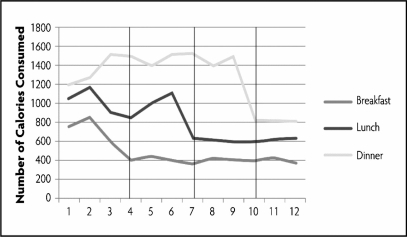
In interrogating the construct validity of Dr.Anderson's study,which of the following might be asked?
A)By what margin did W.J.'s calorie intake improve?
B)How accurate was W.J.'s wife in her calculation of the calories consumed at each meal?
C)Was the number of calories consumed by W.J.going to decrease before surgery anyway?
D)Was Dr.Anderson qualified to analyze the data?

Unlock Deck
Unlock for access to all 55 flashcards in this deck.
Unlock Deck
k this deck
22
The fact that the researcher does not have experimental control over the independent variable and does not randomly assign participants to conditions results in a quasi-experimental design with results in which of the following?
A)The researcher being unable to rule out any threats to internal validity
B)A study that is no different than a correlational design
C)A weaker causal claim than a true experiment
D)An unethical study
A)The researcher being unable to rule out any threats to internal validity
B)A study that is no different than a correlational design
C)A weaker causal claim than a true experiment
D)An unethical study

Unlock Deck
Unlock for access to all 55 flashcards in this deck.
Unlock Deck
k this deck
23
Dr.Anderson is a nutritionist who helps clients lose weight prior to surgery.She is working with W.J. ,a male client who is planning on undergoing a heart transplant.He currently eats more than 3,500 calories a day and has been asked by his doctor to cut the number of calories to about 1,800 (400 for breakfast,600 for lunch,and 800 for dinner).She is curious as to whether a food journal will help W.J.reduce the number of calories he eats.A food journal is used to record everything a person eats.Dr.Anderson decides to phase in the food journal gradually,initially only recording what is eaten at breakfast during the first three days after baseline (days 4-6).During days 7-9,the journal is used at lunch,too,and during days 10-12,it also is used during dinner.Each day,Dr.Anderson's client sends her entries from the food journal and the number of calories he ate at each meal (as calculated by his wife,whose help she enlisted).The data for Dr.Anderson's study are below.

Dr.Natchez,a colleague of Dr.Anderson,questions whether W.J.simply wrote down less in his journal as the study went on because he grew tired of completing this "measure." Dr.Natchez believes he has uncovered which of the following threats to internal validity?
A)Instrumentation threat
B)Experimental demand
C)Testing threat
D)Observer bias

Unlock Deck
Unlock for access to all 55 flashcards in this deck.
Unlock Deck
k this deck
24
In a nonequivalent control group interrupted time series design,the independent variable is studied as:
A)A dependent variable as well
B)Both a repeated measures variable and an independent-groups variable
C)A guarantee of internal validity
D)Frequently as possible
A)A dependent variable as well
B)Both a repeated measures variable and an independent-groups variable
C)A guarantee of internal validity
D)Frequently as possible

Unlock Deck
Unlock for access to all 55 flashcards in this deck.
Unlock Deck
k this deck
25
Which of the following is NOT a small-N design?
A)Interrupted time-series design
B)Stable-baseline design
C)Multiple-baseline design
D)Reversal design
A)Interrupted time-series design
B)Stable-baseline design
C)Multiple-baseline design
D)Reversal design

Unlock Deck
Unlock for access to all 55 flashcards in this deck.
Unlock Deck
k this deck
26
Dr.Anderson is a nutritionist who helps clients lose weight prior to surgery.She is working with W.J. ,a male client who is planning on undergoing a heart transplant.He currently eats more than 3,500 calories a day and has been asked by his doctor to cut the number of calories to about 1,800 (400 for breakfast,600 for lunch,and 800 for dinner).She is curious as to whether a food journal will help W.J.reduce the number of calories he eats.A food journal is used to record everything a person eats.Dr.Anderson decides to phase in the food journal gradually,initially only recording what is eaten at breakfast during the first three days after baseline (days 4-6).During days 7-9,the journal is used at lunch,too,and during days 10-12,it also is used during dinner.Each day,Dr.Anderson's client sends her entries from the food journal and the number of calories he ate at each meal (as calculated by his wife,whose help she enlisted).The data for Dr.Anderson's study are below.

Which of the following does NOT allow Dr.Anderson to conclude that keeping a food journal caused weight loss in W.J.?
A)Lunch calories did not decrease on Day 4.
B)Breakfast calories decreased on Day 4.
C)Dinner calories did not decrease on Day 7
D)Calorie intakes for the three meals differed on Day 1.

Unlock Deck
Unlock for access to all 55 flashcards in this deck.
Unlock Deck
k this deck
27
If a researcher is concerned about external validity,which of the following would you recommend with regard to conducting small-N designs?
A)Do not conduct small-N designs if you are concerned about external validity.
B)Compare the results of a small-N design with other studies.
C)Conduct only reversal designs.
D)Use only one's own clients/patients/students.
A)Do not conduct small-N designs if you are concerned about external validity.
B)Compare the results of a small-N design with other studies.
C)Conduct only reversal designs.
D)Use only one's own clients/patients/students.

Unlock Deck
Unlock for access to all 55 flashcards in this deck.
Unlock Deck
k this deck
28
Dr.Anderson is a nutritionist who helps clients lose weight prior to surgery.She is working with W.J. ,a male client who is planning on undergoing a heart transplant.He currently eats more than 3,500 calories a day and has been asked by his doctor to cut the number of calories to about 1,800 (400 for breakfast,600 for lunch,and 800 for dinner).She is curious as to whether a food journal will help W.J.reduce the number of calories he eats.A food journal is used to record everything a person eats.Dr.Anderson decides to phase in the food journal gradually,initially only recording what is eaten at breakfast during the first three days after baseline (days 4-6).During days 7-9,the journal is used at lunch,too,and during days 10-12,it also is used during dinner.Each day,Dr.Anderson's client sends her entries from the food journal and the number of calories he ate at each meal (as calculated by his wife,whose help she enlisted).The data for Dr.Anderson's study are below.

In interrogating the statistical validity of Dr.Anderson's study,which of the following might be asked?
A)By what margin did W.J.'s calorie intake improve?
B)How accurate was W.J.'s wife in her calculation of the calories consumed at each meal?
C)Was the number of calories consumed by W.J.going to decrease before surgery anyway?
D)Was Dr.Anderson qualified to analyze the data?

Unlock Deck
Unlock for access to all 55 flashcards in this deck.
Unlock Deck
k this deck
29
How does a researcher who conducts a small-N design address external validity concerns about his study?
A)Triangulates his findings with other findings
B)Runs more small-N studies with similar participants
C)Runs more small-N studies with the same participants
D)Runs a large-N study before running a small-N study
A)Triangulates his findings with other findings
B)Runs more small-N studies with similar participants
C)Runs more small-N studies with the same participants
D)Runs a large-N study before running a small-N study

Unlock Deck
Unlock for access to all 55 flashcards in this deck.
Unlock Deck
k this deck
30
Which of the following topics would NOT be especially well-suited to a quasi-experimental design?
A)Does forced evacuation in the face of a natural disaster decrease coping ability?
B)Does watching violent movies cause increases in acceptability of aggression?
C)Does being male lead to poorer parenting skills?
D)Do people diagnosed with a mental illness have poorer social abilities?
A)Does forced evacuation in the face of a natural disaster decrease coping ability?
B)Does watching violent movies cause increases in acceptability of aggression?
C)Does being male lead to poorer parenting skills?
D)Do people diagnosed with a mental illness have poorer social abilities?

Unlock Deck
Unlock for access to all 55 flashcards in this deck.
Unlock Deck
k this deck
31
Seeing stability in a stable-baseline design can help rule out which of the following threats to internal validity?
A)Regression to the mean
B)Placebo effects
C)Attrition
D)Observer bias
A)Regression to the mean
B)Placebo effects
C)Attrition
D)Observer bias

Unlock Deck
Unlock for access to all 55 flashcards in this deck.
Unlock Deck
k this deck
32
In small-N designs,each participant is treated:
A)With multiple interventions
B)By a clinical psychologist
C)As a data point
D)As a separate experiment
A)With multiple interventions
B)By a clinical psychologist
C)As a data point
D)As a separate experiment

Unlock Deck
Unlock for access to all 55 flashcards in this deck.
Unlock Deck
k this deck
33
Dr.Anderson is a nutritionist who helps clients lose weight prior to surgery.She is working with W.J. ,a male client who is planning on undergoing a heart transplant.He currently eats more than 3,500 calories a day and has been asked by his doctor to cut the number of calories to about 1,800 (400 for breakfast,600 for lunch,and 800 for dinner).She is curious as to whether a food journal will help W.J.reduce the number of calories he eats.A food journal is used to record everything a person eats.Dr.Anderson decides to phase in the food journal gradually,initially only recording what is eaten at breakfast during the first three days after baseline (days 4-6).During days 7-9,the journal is used at lunch,too,and during days 10-12,it also is used during dinner.Each day,Dr.Anderson's client sends her entries from the food journal and the number of calories he ate at each meal (as calculated by his wife,whose help she enlisted).The data for Dr.Anderson's study are below.

Which of the following aspects of Dr.Anderson's study might be susceptible to observer bias?
A)The use of the food journal to track calories consumed
B)The conversion by Dr.Anderson of the food journal entries into calories consumed
C)The use of only one manipulation (e.g. ,the food journal)
D)The use of only one dependent variable

Unlock Deck
Unlock for access to all 55 flashcards in this deck.
Unlock Deck
k this deck
34
Which of the following people would be of most interest for a small-N design?
A)A college student
B)A person suffering from a cold
C)A person diagnosed with schizophrenia
D)A psychology student
A)A college student
B)A person suffering from a cold
C)A person diagnosed with schizophrenia
D)A psychology student

Unlock Deck
Unlock for access to all 55 flashcards in this deck.
Unlock Deck
k this deck
35
Dr.Anderson is a nutritionist who helps clients lose weight prior to surgery.She is working with W.J. ,a male client who is planning on undergoing a heart transplant.He currently eats more than 3,500 calories a day and has been asked by his doctor to cut the number of calories to about 1,800 (400 for breakfast,600 for lunch,and 800 for dinner).She is curious as to whether a food journal will help W.J.reduce the number of calories he eats.A food journal is used to record everything a person eats.Dr.Anderson decides to phase in the food journal gradually,initially only recording what is eaten at breakfast during the first three days after baseline (days 4-6).During days 7-9,the journal is used at lunch,too,and during days 10-12,it also is used during dinner.Each day,Dr.Anderson's client sends her entries from the food journal and the number of calories he ate at each meal (as calculated by his wife,whose help she enlisted).The data for Dr.Anderson's study are below.

If Dr.Anderson wanted to keep the same general design,she could use all the following baselines EXCEPT:
A)Number of meals skipped
B)Number of calories consumed based on food type (e.g. ,calories from grains,calories from proteins)
C)Number of calories consumed when eating at home compared to eating in restaurants
D)Number of calories consumed when W.J.ate with friends compared with when he ate with family members

Unlock Deck
Unlock for access to all 55 flashcards in this deck.
Unlock Deck
k this deck
36
According to the textbook,which of the following ethical questions might be posed specifically in reference to a reversal design?
A)Is it ethical to remove an effective treatment?
B)Is it ethical to treat only one person?
C)Can confidentiality be assured?
D)Can consent be given?
A)Is it ethical to remove an effective treatment?
B)Is it ethical to treat only one person?
C)Can confidentiality be assured?
D)Can consent be given?

Unlock Deck
Unlock for access to all 55 flashcards in this deck.
Unlock Deck
k this deck
37
Dr.Anderson is a nutritionist who helps clients lose weight prior to surgery.She is working with W.J. ,a male client who is planning on undergoing a heart transplant.He currently eats more than 3,500 calories a day and has been asked by his doctor to cut the number of calories to about 1,800 (400 for breakfast,600 for lunch,and 800 for dinner).She is curious as to whether a food journal will help W.J.reduce the number of calories he eats.A food journal is used to record everything a person eats.Dr.Anderson decides to phase in the food journal gradually,initially only recording what is eaten at breakfast during the first three days after baseline (days 4-6).During days 7-9,the journal is used at lunch,too,and during days 10-12,it also is used during dinner.Each day,Dr.Anderson's client sends her entries from the food journal and the number of calories he ate at each meal (as calculated by his wife,whose help she enlisted).The data for Dr.Anderson's study are below.

What type of small-N design has Dr.Anderson used with W.J.?
A)Interrupted time-series design
B)Stable-baseline design
C)Multiple-baseline design
D)Reversal design

Unlock Deck
Unlock for access to all 55 flashcards in this deck.
Unlock Deck
k this deck
38
Which of the following can NOT typically be applied to a small-N experiment?
A)Experimental control
B)Manipulation of variables
C)Inferential statistics
D)Replication
A)Experimental control
B)Manipulation of variables
C)Inferential statistics
D)Replication

Unlock Deck
Unlock for access to all 55 flashcards in this deck.
Unlock Deck
k this deck
39
A small-N design that involves providing treatment and then removing treatment is known as a/an:
A)Interrupted time-series design
B)Stable-baseline design
C)Multiple-baseline design
D)Reversal design
A)Interrupted time-series design
B)Stable-baseline design
C)Multiple-baseline design
D)Reversal design

Unlock Deck
Unlock for access to all 55 flashcards in this deck.
Unlock Deck
k this deck
40
Dr.Anderson is a nutritionist who helps clients lose weight prior to surgery.She is working with W.J. ,a male client who is planning on undergoing a heart transplant.He currently eats more than 3,500 calories a day and has been asked by his doctor to cut the number of calories to about 1,800 (400 for breakfast,600 for lunch,and 800 for dinner).She is curious as to whether a food journal will help W.J.reduce the number of calories he eats.A food journal is used to record everything a person eats.Dr.Anderson decides to phase in the food journal gradually,initially only recording what is eaten at breakfast during the first three days after baseline (days 4-6).During days 7-9,the journal is used at lunch,too,and during days 10-12,it also is used during dinner.Each day,Dr.Anderson's client sends her entries from the food journal and the number of calories he ate at each meal (as calculated by his wife,whose help she enlisted).The data for Dr.Anderson's study are below.

In examining the external validity of her study,Dr.Anderson is probably most concerned about making sure her study generalizes to:
A)All men
B)All transplant recipients
C)All overweight people
D)She is probably not very concerned about external validity

Unlock Deck
Unlock for access to all 55 flashcards in this deck.
Unlock Deck
k this deck
41
Dr.Fletcher is interested in understanding whether joining a fraternity/sorority causes people to become more concerned about their attractiveness and appearance.He recruits a group of 55 freshmen (25 males,30 females)who are planning to go through fraternity/sorority recruitment on his campus.After they join,he gives them a measure of attractiveness concern/appearance concern (the Body Concern Scale,where higher scores indicate higher body concerns).
In addition to measuring the group of participants who joined a fraternity/sorority,Dr.Fletcher decides to give the same measure to another group of 55 participants who decided to not join a fraternity/sorority.Based on the results below,explain whether Dr.Fletcher should be concerned about a maturation threat to internal validity.
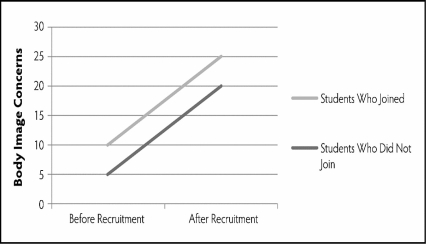

Unlock Deck
Unlock for access to all 55 flashcards in this deck.
Unlock Deck
k this deck
42
Lara is conducting a study for her research methods class.She is curious if participating in a collegiate study-abroad program causes people to become more accepting of other cultures.Provide an example of an independent-groups quasi-experimental design and an example of a within-groups quasi-experimental design using Lara's research question.

Unlock Deck
Unlock for access to all 55 flashcards in this deck.
Unlock Deck
k this deck
43
List three small-N designs and explain how these designs address maturation.

Unlock Deck
Unlock for access to all 55 flashcards in this deck.
Unlock Deck
k this deck
44
Explain how interrogating the statistical validity of a small-N design is different from interrogating the statistical validity in a large-N design.

Unlock Deck
Unlock for access to all 55 flashcards in this deck.
Unlock Deck
k this deck
45
List the three differences between small-N and large-N designs.

Unlock Deck
Unlock for access to all 55 flashcards in this deck.
Unlock Deck
k this deck
46
Layne is trying to watch less television.Her friend Ryan is a psychologist who agrees to help her.He creates a treatment plan that involves giving Layne $5 for every day that she watches fewer than 90 minutes of television.He monitors her television watching for three days,treats her for three days and monitors her,and then just monitors her for three more days.
What type of design is Ryan using to change Layne's behavior? Name a threat to internal validity that this design is well suited to address.

Unlock Deck
Unlock for access to all 55 flashcards in this deck.
Unlock Deck
k this deck
47
Explain why quasi-experiments offer a trade-off between internal validity and external validity.

Unlock Deck
Unlock for access to all 55 flashcards in this deck.
Unlock Deck
k this deck
48
Dr.Fletcher is interested in understanding whether joining a fraternity/sorority causes people to become more concerned about their attractiveness and appearance.He recruits a group of 55 freshmen (25 males,30 females)who are planning to go through fraternity/sorority recruitment on his campus.After they join,he gives them a measure of attractiveness concern/appearance concern (the Body Concern Scale,where higher scores indicate higher body concerns).
As the study is described,explain a selection threat that may be present in Dr.Fletcher's study.What could Dr.Fletcher do to address this threat?

Unlock Deck
Unlock for access to all 55 flashcards in this deck.
Unlock Deck
k this deck
49
Layne is trying to watch less television.Her friend Ryan is a psychologist who agrees to help her.He creates a treatment plan that involves giving Layne $5 for every day that she watches fewer than 90 minutes of television.He monitors her television watching for three days,treats her for three days and monitors her,and then just monitors her for three more days.
Imagine that Ryan and Layne's study finds the following pattern of results.Explain why the data below are especially convincing because of the second baseline/reversal.Name a specific threat that these data address.
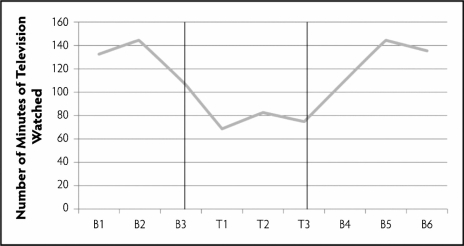

Unlock Deck
Unlock for access to all 55 flashcards in this deck.
Unlock Deck
k this deck
50
Dr.Fletcher is interested in understanding whether joining a fraternity/sorority causes people to become more concerned about their attractiveness and appearance.He recruits a group of 55 freshmen (25 males,30 females)who are planning to go through fraternity/sorority recruitment on his campus.After they join,he gives them a measure of attractiveness concern/appearance concern (the Body Concern Scale,where higher scores indicate higher body concerns).
Explain why Dr.Fletcher is conducting a quasi-experimental design rather than a true experiment.

Unlock Deck
Unlock for access to all 55 flashcards in this deck.
Unlock Deck
k this deck
51
Layne is trying to watch less television.Her friend Ryan is a psychologist who agrees to help her.He creates a treatment plan that involves giving Layne $5 for every day that she watches fewer than 90 minutes of television.He monitors her television watching for three days,treats her for three days and monitors her,and then just monitors her for three more days.
Imagine that Ryan and Layne's study finds the following pattern of results.Explain whether Ryan and Layne should conclude that the $5 treatment is effective at decreasing television viewing and whether they should be concerned by an instrumentation threat.(In the graph,B indicates baseline and T indicates Treatment. )
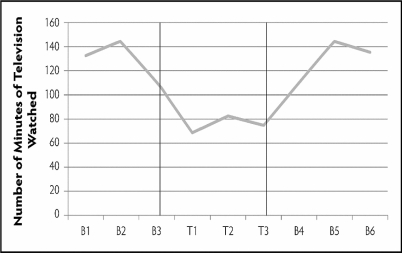

Unlock Deck
Unlock for access to all 55 flashcards in this deck.
Unlock Deck
k this deck
52
Provide a reason a researcher might want to conduct a small-N design.Provide a reason why a researcher might want to avoid conducting a small-N design.

Unlock Deck
Unlock for access to all 55 flashcards in this deck.
Unlock Deck
k this deck
53
Dr.Fletcher is interested in understanding whether joining a fraternity/sorority causes people to become more concerned about their attractiveness and appearance.He recruits a group of 55 freshmen (25 males,30 females)who are planning to go through fraternity/sorority recruitment on his campus.After they join,he gives them a measure of attractiveness concern/appearance concern (the Body Concern Scale,where higher scores indicate higher body concerns).
In addition to measuring the body concern of the participants who joined a fraternity/sorority immediately before and immediately after they join,Dr.Fletcher measures them for the three weeks before and the three weeks after.Based on the results below,explain whether Dr.Fletcher should be concerned about a testing threat to internal validity.
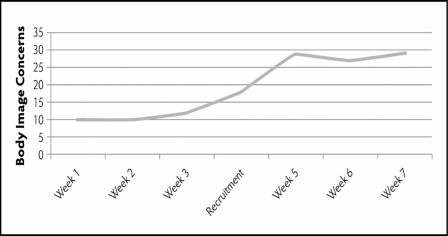

Unlock Deck
Unlock for access to all 55 flashcards in this deck.
Unlock Deck
k this deck
54
Dr.Fletcher is interested in understanding whether joining a fraternity/sorority causes people to become more concerned about their attractiveness and appearance.He recruits a group of 55 freshmen (25 males,30 females)who are planning to go through fraternity/sorority recruitment on his campus.After they join,he gives them a measure of attractiveness concern/appearance concern (the Body Concern Scale,where higher scores indicate higher body concerns).
In addition to measuring the group of participants who joined a fraternity/sorority,Dr.Fletcher decides to give the same measure to another group of 55 participants who decided to not join a fraternity/sorority.Based on the results below,explain whether Dr.Fletcher should be concerned about a history threat to internal validity.
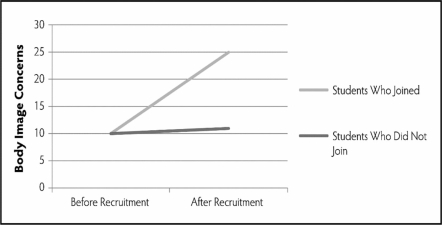

Unlock Deck
Unlock for access to all 55 flashcards in this deck.
Unlock Deck
k this deck
55
Explain why quasi-experiments and correlational studies can be seen as similar but why quasi-experiments are superior.

Unlock Deck
Unlock for access to all 55 flashcards in this deck.
Unlock Deck
k this deck



